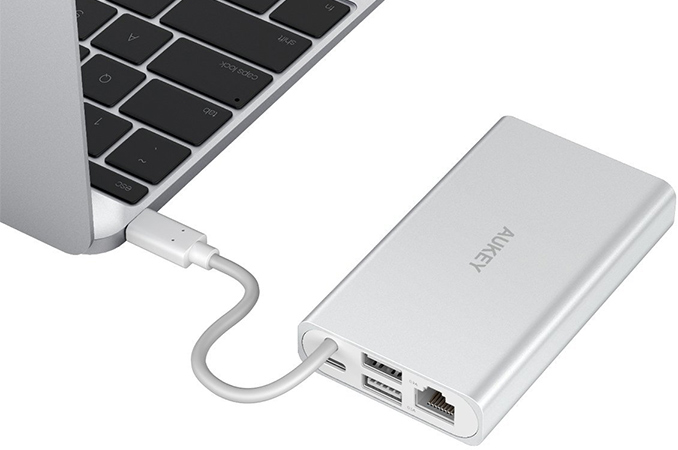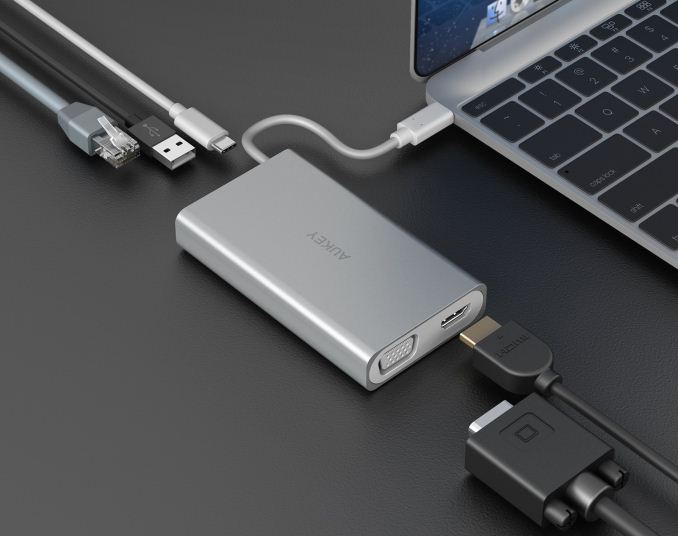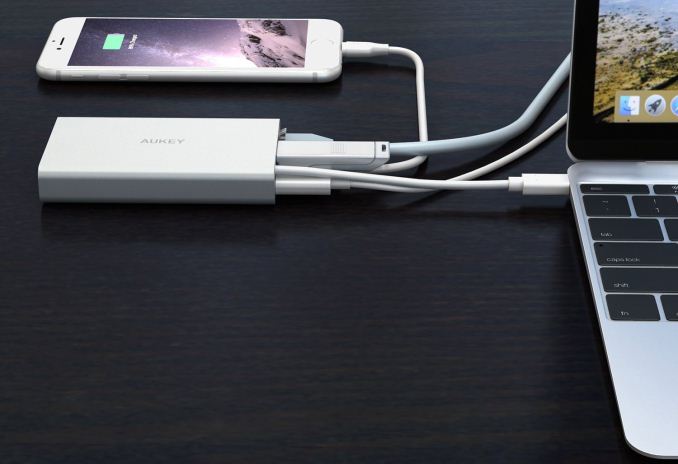AUKEY’s CB-C55 USB-C Hub Now on Sale: Macbook Port Expander with Power and Ethernet
by Anton Shilov on March 29, 2017 5:00 PM EST- Posted in
- USB-C
- Apple
- MacBook Pro
- Aukey
- USB-C Hub

AUKEY has started to sell its latest USB Type-C hub for Apple’s MacBook laptops and other computers that need something more than USB-C and wireless interconnection technologies. The new CB-C55 hub expands the port allocation to provide outputs for displays, projectors, Gigabit Ethernet and traditional USB Type-A devices, along with supporting power delivery input to the main machine.
Modern notebooks are very thin, whereas legacy ports like 8P8C/RJ45 (Ethernet) and D-Sub were designed in the seventies and the eighties when PCs only existed in desktop form-factors. Even more modern ports such as the HDMI port were not designed for ultra-thin laptops. Today, it is either impossible or very complicated to install such ports into ultra-thin notebooks, and the opinion of some OEMs is to combine them into a single USB-C port and require additional dongles. As a result, various dock stations and USB Type-C hubs are gaining popularity because people still need their legacy devices/connections, but want to have the thinnest and lightest devices possible.
The AUKEY CB-C55 USB Type-C hub was designed primarily for road warriors who use modern ultra-thin devices such as Apple’s MacBook, MacBook Pro (2017), HP’s Spectre, Lenovo’s Yoga 900, Google’s Pixel and others. The CB-C55 has a two USB Type-A connectors, a D-Sub header (max resolution is 1920×1080), an HDMI output (max resolution is 3840×2160 at 30 Hz) as well as a GbE port. The unit is made of matte aluminum and weighs 120 grams.
| AUKEY 6-in-1 USB Type-C Hub | |||
| CB-C55 | |||
| Main Connection | USB 3.0 Type-C at 5 Gbps with power delivery | ||
| Display Outputs | D-Sub (max resolution is 1920×1080) HDMI 1.4 (max resolution is 3840×2160 at 30 Hz) |
||
| Ethernet | GbE | ||
| USB | 2 × USB 3.0 Type-A (5V 500mA - 5V 900mA) | ||
| Power Input | 5-12V 2A (up to 24 W) | ||
| Cable Length | 142 mm 5.6 inches |
||
| Dimensions | 102 × 58 × 18 mm 4 × 2.3 × 0.7 inches |
||
| Weight | 120 grams 4.2 ounces |
||
Like many other USB hubs from AUKEY, the CB-C55 has its own power connector and thus can power laptops as well as devices that can be charged using USB ports. The input of the CB-C55 is 5-12 V at 2 A, so, the maximum amount of power it can deliver is about 24 W. Meanwhile, since the CB-C55 only supports USB 3.0 Type-C interconnection, the maximum bandwidth it can provide to other devices is limited to 5 Gbps.
The AUKEY CB-C55 USB-C hub is currently available from Amazon for $99.99, down $30 from the typical price of the product, which is $129.99, according to the retailer. The hub is backed by a two-year warranty.
Related Reading:


















34 Comments
View All Comments
Guspaz - Thursday, March 30, 2017 - link
It's worth noting that even with all four channels dedicated to DisplayPort, you still have two channels of USB 2.0. Not ideal for storage, but lots of peripherals (like a mouse, for example) is fine with USB 2.DisplayPort 1.3 should also be able to handle 4K60 with only two channels, since it supports 4K120 with four channels. DisplayPort 1.4 is basically the same as 1.3 but with compression, but you shouldn't need compression to do 4K60 in two channels.
melgu - Wednesday, April 19, 2017 - link
Apple didn't cheap out at all on the ports. There are 4 Thunderbolt 3 Ports which each support 2 4K or 1 5K monitor at 60 Hz*. The problem is, that USB 3 doesn't offer enough bandwidth. So the problem is with the dock not with Apple.*The Graphics card doesn't support 8 4K monitors (only 2), but the Thunderbolt connections themselves would.
lmcd - Wednesday, March 29, 2017 - link
One of the worst things about all of these for me is that no one is testing Windows 10 Mobile compatibility. If Anandtech ever gets one of these in, please send it to anyone on the team with a W10 phone and let us know compatibility.HomeworldFound - Wednesday, March 29, 2017 - link
They can't even do proper benchmarks on CPU's and GPU's together due to two staff members being in different countries. It would be easier if you try it.satai - Thursday, March 30, 2017 - link
Win 10 Mobile Is dead anyway...negusp - Thursday, March 30, 2017 - link
Do you really think any of the AT team uses a Windows phone? lol...You're probably 1 of maaaybe 11 people that want to know WMobile compatibility.
Samus - Wednesday, March 29, 2017 - link
Real solution: make the laptop a few millimeters thickerFake solution being pushed on consumers: spend hundreds more on laptop because it's thin, then spend hundreds more on dongles to add weight and thickness. and don't forget: none of these machines meet DOD STD810G specifications like the models that are 1.4mm thicker (comparing the envy to the elitebook 1030, for example.)
koaschten - Thursday, March 30, 2017 - link
Excuse me WHAT?Why would a normal person need a laptop that can withstand freezing rain or work in a salt water fog atmosphere?
"MIL-STD-810 addresses a broad range of environmental conditions that include: low pressure for altitude testing; exposure to high and low temperatures plus temperature shock (both operating and in storage); rain (including wind blown and freezing rain); humidity, fungus, salt fog for rust testing; sand and dust exposure; explosive atmosphere; leakage; acceleration; shock and transport shock; gunfire vibration; and random vibration. "
DanNeely - Thursday, March 30, 2017 - link
because the full set consist of things that are more or less gimmies for anything (thermal/air pressure/etc) things that are useful for accident mitigation (drop/spill testing) and ones that become gimmies once you have the group in the middle in place (eg waterproof is generally dust proof). And because MIl-STD-810 is what various better known protected notebooks (eg Panasonic Toughbook) use, doing the same testing lets the OEM imply they're as good as the gold standard. (Even if not necessarily the case, there're multiple levels of protection defined in the standard.)BrokenCrayons - Thursday, March 30, 2017 - link
There's nothing much to be done about it. Reducing laptop thickness has been a popular and commonplace objective of OEMs for decades. Yes, in recent times there's been a lot more momentum behind that effort that'd driven it to the point where it's reasonable to argue that we've give up a lot of utility and durability to achieve a nearly meaningless goal, but these things wouldn't exist if they didn't attract buyers.